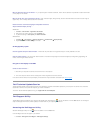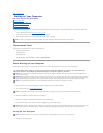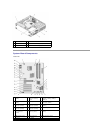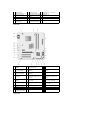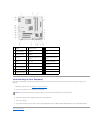
Test the electrical outlet — Ensure that the electrical outlet is working by testing it with another device, such as a lamp.
Eliminate possible interference — Turn off nearby fans, fluorescent lights, or halogen lamps to check for interference.
Run the speaker diagnostics
Reinstall the sound driver
Run the Hardware Troubleshooter — See Hardware Troubleshooter.
No sound from headphones
Check the headphone cable connection — Ensure that the headphone cable is securely inserted into the headphone connector (see Inside View of Your
Computer).
Adjust the Windows volume control — Click or double-click the speaker icon in the lower-right corner of your screen. Ensure that the volume is turned up and
that the sound is not muted.
Video and Monitor Problems
The screen is blank
The screen is difficult to read
Check the monitor cable connection —
l Ensure that the monitor cable is connected to the correct graphics card.
l If you are using the optional DVI-to-VGA adapter, ensure that the adapter is correctly attached to the graphics card and monitor.
l Ensure that the monitor cable is connected as shown on the setup diagram for your computer.
l Remove any video extension cables and connect the monitor directly to the computer.
l Swap the computer and monitor power cables to determine if the monitor's power cable is defective.
l Check the connectors for bent or broken pins (it is normal for monitor cable connectors to have missing pins).
Check the monitor power light —
l If the power light is lit or blinking, the monitor has power.
l If the power light is off, firmly press the button to ensure that the monitor is turned on.
l If the power light is blinking, press a key on the keyboard or move the mouse to resume normal operation.
Test the electrical outlet — Ensure that the electrical outlet is working by testing it with another device, such as a lamp.
Check the diagnostic lights —
See Power Lights.
Check the monitor settings — See the monitor documentation for instructions on adjusting the contrast and brightness, demagnetizing (degaussing) the
monitor, and running the monitor self-test.
CAUTION: Before you begin any of the procedures in this section, follow the safety instructions that shipped with your computer. For additional
safety best practices information, see the Regulatory Compliance Homepage at www.dell.com/regulatory_compliance.
NOTICE: If your computer came with a PCI graphics card installed, removal of the card is not necessary when installing additional graphics cards;
however, the card is required for troubleshooting purposes. If you remove the card, store it in a safe and secure location. For information about your
graphics card, go to support.dell.com.
NOTE: For troubleshooting procedures, see the monitor's documentation.












